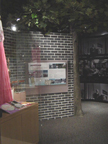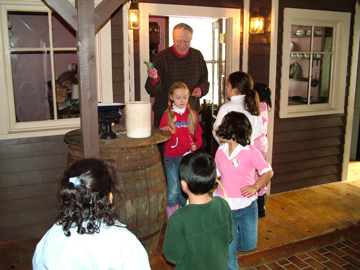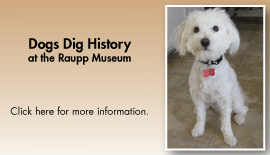Raupp Museum

Every season, the Raupp Museum features special programs for both children and adults. For more information, or to register for these programs, please contact the Raupp Museum.
Click here for current Raupp Museum program offerings.
Raupp Museum
901 Dunham Lane
Buffalo Grove, IL 60089
Office Phone: (847) 459-2318
Office Fax: (847) 459-3148
Hours:
| Monday - Thursday: | 11 a.m. - 4:30 p.m. |
| Friday & Saturday: | Closed |
| Sunday: | 1 - 4 p.m. |
Galleries
School Programs
Scout Programs
Buffalo Grove History
Galleries
The Raupp Museum features 3 exciting exhibit galleries:
 The Main Gallery tells the story of the history of Buffalo Grove, beginning with Potawatomi life in the 1830s, continuing through early farm settlement, and arriving at the bustling suburb of today. Visitors to this exhibit can look at a Potawatomi garden, sit on the porch of
The Main Gallery tells the story of the history of Buffalo Grove, beginning with Potawatomi life in the 1830s, continuing through early farm settlement, and arriving at the bustling suburb of today. Visitors to this exhibit can look at a Potawatomi garden, sit on the porch of
an 1890s house, milk a replica dairy cow and much more.

The Town Square Gallery represents downtown Buffalo Grove of the early 1900s. Visitors are able to try a water pump, and peek into the windows of a Clothing Store, Tavern, Livery Stable, Pharmacy, and more.
The Lower Gallery features a roster of changing exhibits.

School Programs
The Raupp Memorial Museum is proud to offer several exciting educational programs for school, Scout and community groups. The following programs are available Monday - Friday between 9 a.m. and 5 p.m. Please contact Debbie Fandrei at (847) 459-2318 to schedule one of the following great programs.
Archaeology
Grade: 5 - 8
Illinois State Board of Education Goals met: 11A, 13B, 16A, 16C, 16D, and 16E
Educational Packet Available

First, students participate in an introductory presentation about archeology, exploring what archeology is, how archeologists determine where to dig, and the ways in which archeology is used as a historical resource. Next, students divide up into teams of 3 to take part in a mock dig that is set up outside of the museum, with each student acting as the digger, map maker and sand-hauler in turn. After that, the teams of students regroup to pool their information, analyze what they found in the dig, and construct their interpretation of the story. Finally, as post-program option, the museum has a set of ethical dilemmas regarding archeology which students can use as discussion points in class, or could be used as essay or journal-writing assignments.
Can you do the program at my school instead of at the museum? We're afraid not. The mock dig uses 2,000 pounds of sand, so it is not something that can be moved from school to school.
Cows Are Cool
Grade: Preschool - 3
This fun program introduces children to the life of a dairy farmer in turn-of-the-century Buffalo Grove. Participants get a hands-on experience by milking the museum's working replica dairy cow, churning butter and playing old-fashioned games.

Buffalo Grove Then & Now
Grade: 1 - 5
Educational Packet Available
This program showcases the changes that have occurred in Buffalo Grove during the past 100 years. First, students look at a series of artifacts that span a century to see how one object changes over time. Then, a slide show contrasts pictures of past Buffalo Grove buildings with the buildings that currently stand in those locations. Finally, an artifact guessing game encourages children to have fun with history.
Tiny Traders
Grade: K - 2
Illinois State Learning Goals met: 6B, 6C, 7A, 7C, 15B, 15D, 18C

This exciting program lets students experience what it was like when a farmer went shopping 125 years ago. First, students milk the museum’s replica cow, gather chicken eggs and get a shopping list. Next, they sell their milk for money at the creamery. Finally, they go shopping in the Town Square, where they can use their money and eggs to buy and barter for things on their shopping list.
This is the perfect way to teach younger students the difference between buying and bartering, the difference between needs and wants, and the connection between work and money.
Please note: This program requires 1 parent chaperone per 8 to10 students, and it must be done at the museum.
Potawatomi Pathways
Grade: Preschool - 5
Educational Packet Available
This program on Native American history allows students to touch reproduction Potawatomi artifacts, listen to a Native American folktale, and play a hands-on game with animal footprints. Older students can try a different game which allows them to simulate a Native American trading post.
Packing For Pioneer Life
Grade: 3 - 4
Educational Packet Available
This program covers Buffalo Grove’s history from settlement to the 1850s. Students start by brainstorming a pioneer’s needs in settling Buffalo Grove. Next, the museum educator opens a pioneer trunk filled with reproduction artifacts, and students discuss the uses of each item and which pioneer need the item would fulfill. Finally, students use their new knowledge in a hands-on packing activity.
Women, Wardrobes, & WWII
Grade: 8 - 12
Educational Packet Available
Did short skirts help win WWII? Find out! This fun program looks at the fashion changes caused by World War II. Students will see examples of 1940s advertising, vintage clothing and World War II artifacts from the collection of the Raupp Museum as the museum educator speaks about the government’s clothing regulations during the war, and what effect they had on women and fashion.

Buffalo Grove History
Buffalo Grove Timeline
1834 - The first settlers from New England arrive in the Buffalo Grove area.
1846 - John Simon Henneman settles in Buffalo Grove and sends for his family in Germany.
1847 - Jacob “Little Jake” Weidner (or “Klein Jake” in German) arrives in Buffalo Grove. Melchoir Raupp finds a good farmstead in Buffalo Grove. The first Catholic Mass is celebrated in the home of John Simon Henneman.
1852 - St. Mary’s Catholic Church is built for $300 and the first Mass is held on September 16.
1853 - Melchoir Raupp buys his first farm, 187 acres, for $1,975.
1855 - St. Mary’s Church burns down on February 19, and it is rebuilt over the course of the next year. The first St. Mary’s School is a log cabin.
1860s - The General Store is built.
1898 - J.G. Weidner & Sons General Store becomes Weidner Bros.
1899 - The present old St. Mary’s Church is constructed for $28,000.
1900 - Mike Firnbach builds his tavern and hall, “Little Mike’s Place” (later known as the Buffalo House).
1930s - The Welter family operates Buffalo Grove’s first gas station on McHenry Road (Route 83).
1947 - The present St. Mary’s School is built. The old school becomes the rectory.
1957 - Descendants of Melchoir Raupp sell the farm to developer Al Frank and the first subdivision housing is built.
1958 - The Village of Buffalo Grove is incorporated on March 7 with a population of 164 people. William Clohesy is elected the first Village President.
1959 - The Police Department gets its first emergency vehicle. The Wheeling Public Library District is incorporated.
1960 - The Buffalo Grove Recreation Association is organized. Alcott Elementary School opens.
1961 - Buffalo Grove population is 1,492 people. The Volunteer Fire Department/Rescue Squad is established and gets its first ambulance. Jack London Junior High School opens.
1962 - The first Buffalo Grove Days is held. Emmerich Park is dedicated.
1963 - Buffalo Grove population is 3,429 people. The first full-time police officer is hired.
1964 - Ranch Mart Shopping Center (presently The Plaza at Buffalo Grove and Dundee Roads) opens.
1966 - Joyce Kilmer School opens. Buffalo Grove Road is widened to 4 lanes.
1967 - Buffalo Grove population is 6,900 people. Levitt and Sons’ Strathmore subdivision models open at Arlington Heights and Dundee Roads. The first apartment complex, the Buffalo Grove Apartments, is built.
1969 - Beth Judea becomes the first synagogue in this area. The Buffalo Grove Park District is incorporated.
1972 - Buffalo Grove population is 15,653 people. Temple Chai is started. Buffalo Grove High School opens.
1979 - The Raupp Museum is dedicated.
1983 - The Spoerlein family sells their farm, which becomes Spoerlein Farms townhomes and Spoerlein Commons shopping complex.
1997 - Buffalo Grove population is over 40,000 people.
Buffalo Grove History
The very first pioneers to come to the Buffalo Grove area came from New England around 1834, and stayed for about 5 years. Many of them had received land grants from the government and came to settle on their frontier property. Early land records show a mix of English, French and Scotch names including Stephen Lamb, Napoleon Periolet, Richard Adams, John Foster, Job Tripp, Darius Rice, William Flemming, Samuel Mills, Jonathan Luce, Stephen Olcott and Joseph McDuffee. Captain Daniel Wright and Mr. Amos Bennet have been recognized as the first non-native settlers in Lake County.
In the 1840s many of the first homesteaders and land speculators sold their land to the German immigrants fleeing their homeland. Living conditions in Germany were bad, so the cheap yet fertile land in America was very appealing. Most Buffalo Grove area pioneers settled by people who shared their religion and nationality. German Catholics mainly settled together in the Buffalo Grove area, German Lutherans decided to live in Long Grove, and German Presbyterians moved to Wheeling. After they bought the land, the settlers worked to turn the early farms and wilderness into their own community.
Who were the first settlers in Buffalo Grove? It is hard to tell. Many families sent one person ahead to see if Buffalo Grove was a good place to live, and if they thought it was, the rest of the family would follow. Some say that John Simon Henneman came in 1846 and sent word to family and friends in Germany for them to come to Buffalo Grove. Jacob Weidner, who was known as Little Jake, was 27 years old when he came to Buffalo Grove to scout out the area for his family. Little Jake liked the land so much that he asked his father, his 5 brothers, his uncle and their families to come live in Buffalo Grove.
Melchoir Raupp was the settler who had the longest journey before ending up in Buffalo Grove. He first came to Buffalo Grove in 1847, but he was not able to buy the farm he wanted. Next, he traveled to Wisconsin to see if he would like it there. He thought the farmland looked good, but he also thought there were not enough people, and it would be too lonely to live there. Melchior then headed west on a wagon train after hearing about the gold in California. The few nuggets that Melchoir found did not make him rich, in fact, he had to walk back to Buffalo Grove. When he got back, he took a job with a farm family until he was able to earn enough money to buy the farm he wanted and start a family.
These first Buffalo Grove families formed a very close community, with a high rate of intermarriage. Religion and education were two of the most important aspects of their new community. At first, both church services and school lessons were held in pioneers’ homes, but soon they realized a separate church and school would be good for the community. The settlers built the first St. Mary’s Church in 1852 and the first St. Mary’s School in 1855. By 1899, downtown Buffalo Grove had grown with the addition of the Firnbach Tavern and the Weidner General Store. Even though most of the pioneer families in Buffalo Grove are gone now, you can still remember their names, because many streets and parks are named after the families who originally settled in that area.








